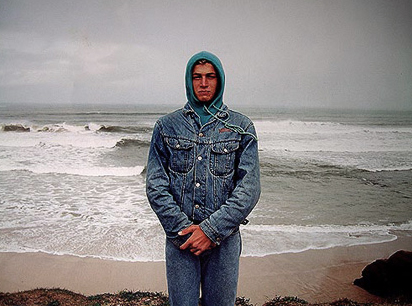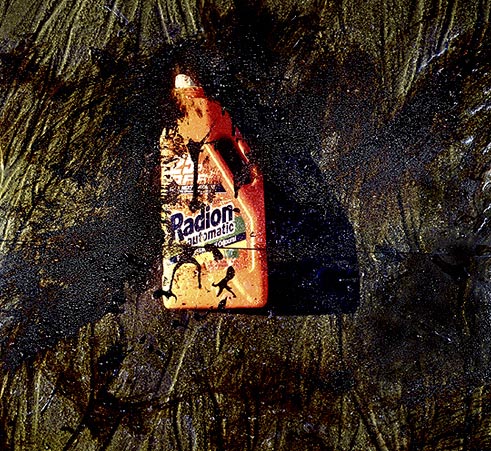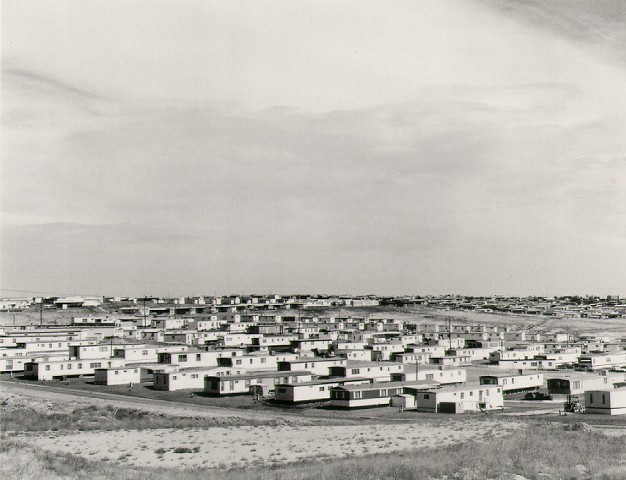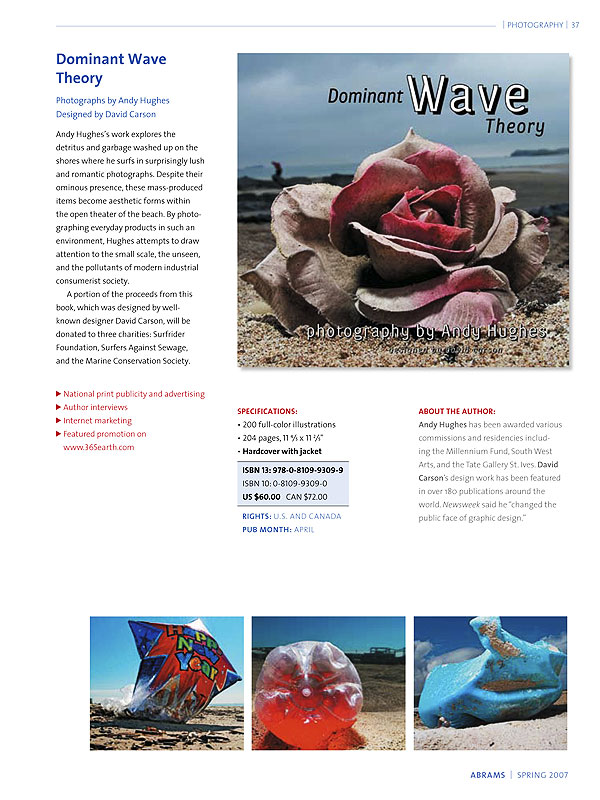|
|
| home | features | exhibitions | interviews | profiles | webprojects | gazetteer | links | archive | forum |
|
Andy Hughes on photography, surfing and Dominant Wave Theory Interview by Rupert White
Shall we start with your upbringing and education? Where did you
live, and who or what were your formative influences? I grew up in Castleford, West Yorkshire. My father was a painter and decorator, my grandfather was a miner. Many in the town worked in the coal mining industry. In fact its been interesting seeing the Channel 4 program on TV about the town. After the closure of the coal mines the town and its fortunes fell rapidly. At the age of 17 the miner's strike was at full steam. It was during this time that I was given a 35 mm camera by my gran. I spent much time on the picket lines making photographs and responding in my own way during very difficult times. My art studies began at Wakefield College, the Fine Art Course at Cardiff and then in 1989 studied Photography at the Royal College of Art. All was funded through grants and bursaries. I am the only member of any of my family ( extended ) to go to University. I feel that although I have spent all my adult life away from this part of England it would be very difficult to return. I very rarely visit.
Title: Surfer, Peniche, Portugal, 1991 Medium : C-Type Print 16x20
At the RCA we had various tutors and guest speakers, but really I suppose the most impressionable memories were regarding the work of ones peers and the relationships that one generates from studying at such a place. I was also fortunate in going to Lisbon for a term with others from my year. We surfed a bit and really that helped me generate work for my final show. Spending time at the beach was probably the most productive time for me then, it helped to cement an interest in the beach as my subject. Shortly after graduating I worked in London for a while and then took a teaching post in Norfolk. Soon after, around 1993 I had a call from the Tate St Ives. The gallery was not yet open and they had decided to offer a residency type post to a 'surfer/artist'. Many, many years later on the grapevine I heard a rumor that 'Andy was asked to do the residency because of his links with the beach, surfing communities and Surfers against Sewage - not because of his work!' Make what one likes of that. I'd say that in retrospect I'm pragmatic about the reasons why and how one achieves one's goals whether artistic or otherwise.
Title: Radion 1991 Medium: C-type with dirty oil
I did n't realise that you had been working with SAS before the residency. Can you explain your involvement and just say something about the SAS cause in general? In 1991 I was working on a series of portraits and related matter on the beach, SAS had just started up and I saw a feature in a national newspaper. All before the advent of e-mail and the web, I made contact and came to Cornwall and lived in a house with a bunch of surfers in Porthtowan (before the Tate residency). As a result of this I developed friendships and so on, when needed I provided some image based work for the campaign, went on demos etc. Yes of course SAS played a very significant role in the agenda for ' taking care of the environment'. Its grass roots approach made many headlines and achieved a great deal in respect of the clean up of sewage related waste. Ive always helped the group in any way I could. Perhaps things have now moved forward so much that they have achieved many of their original goals, perhaps its time to re-group and act as a voice for surfers and water users in general, perhaps like 'surfrider', campaigning for all issues about the specificity of the beach as a habitat. Time will tell.
So in 1993 you became the first resident artist at the Tate. What kind of work were you making at the time and how did it evolve during the year's residency? Looking back on it now, how important and helpful was the residency?
Title: Knee Boarder, Porthmeor Beach, 1993 Medium : 16 x 20 C-type From Tate Residency
I'd say that the time I spent at the Tate was very worthwhile, looking back, it is the social relationships that one makes, perhaps an often overlooked fact. One learns so much, not just practice, but about how one can create interfaces with all kinds of people. I think its easy to forget that whilst we often really desire respect from our peers and other artists, a placement at a gallery like the Tate brings you into contact with other members of the public who have a very varied range of attitudes and interests. Since 1993 I have of course worked with the Tate on many levels, as an artist and facilitator with various community groups, sometimes there's a hierarchy of activities where 'serious' art is distinguishable from other ways of working. Some of the high points have been seeing the smile on someone's face when they make something or 'get it'. Over the recent past the Tate has come in for quite some flack on the art forum site, if one can separate the 'corporate face' from all of the comments, the gallery and its background work is a real asset. Yes of course it has helped me for sure when applying for other grants etc and it has definitely enabled me to continue working and helped cement my relationship to Cornwall, for which I am grateful.
You opted to stay in Cornwall after you finished at the Tate. Which other artists did have you have contact with during this period? What impression did you have of the art-scene in St Ives at the time and how do you think you fitted into it? I moved to St Ives permanently in 1995, and soon after Andy Whall came here to live, and Graham Gaunt too. There was a kind of feeling that there weren't too many younger artists - well I mean in their thirties or so.
This age thing - art demographics in Cornwall - is quite important to acknowledge. I remember St Ives then, and most of the artists that were around seemed to be in their fifties and older. Most had memories of the glory days, and all of them seemed to have an unflinching loyalty to modernism and the legacy of St Ives. It felt like it was going to be difficult to do anything else.
Regarding other artists in the town, I've always felt that St Ives is my home, even though I do not live there anymore, in terms of my work I have always felt a slight disconnect really, whilst I know a number of artists like Richard Nott and Sax Impey and others I admire, I don't really pay too much attention to what goes on really in the majority of galleries. Although I contribute to this website I think that much of what preoccupies many of the artist in St Ives is not on my radar. I'm more interested in specific photographic practice, which resides outside the county in terms of subject and discourse. I suppose I'm more interested in American Photographers, particularly in terms of the Californian West Coast aesthetic. The New Topographic movement and the sensibilities which have been developed from that period have provide me with one of many starting points.
Robert Adams Untitled, Denver 1970-74
Can you give some examples? Which photographers are you talking about here? The "New Topographics" movement emerged in the 1960's as a reaction to the pictorialist, utopian photography of photographers such as Ansel Adams and Edward Weston. The well known 'greats' such as Adam and Weston depicted the landscape as an entity of unscathed and organic beauty. Whereas the New Topographics movement developed work which explored the increasing imprint that man was having on the landscape. Massive suburban development started to spread across the USA, artists such as Robert Adams, Lewis Baltz, Stephen Shore, Nicholas Nixon, Joe Deal and Bernd and Hilla Becher, among others; endeavored to objectively show the effects of an increasingly industrial culture. They turned their cameras towards newly built tract houses, industrial parks, expansive highways and commercial shopping malls as proof of man's increased grip and development of both the rural and suburban landscape. What is so remarkable about these photographs is the stark juxtaposition between humanity and its environment. The pinnacle of this movement came to fruition in an exhibition entitled, New Topographics: Photographs of a Man-Altered Landscape. In St Ives photography as art practice as opposed to commerce has had no impact, obviously such practice needs support in many forms, talking outside of financial issues, there are very very few working with the medium in its 'purest' form outside of the image as document serving other purposes, for recording and so on. The general public think of it in terms of recording the picturesque, many examples of which can be seen in St Ives and on 'local' photographers websites. Working with photography is not really on the radar in Cornwall and to be honest still isn't. I felt OK about that because the work I had started was, I felt, directly in the opposite direction of many working in the town. This is explored in my book, perhaps its worth referring to the Chris Short essay here as it make sense in relationship to the question...
Spread from book: 'Dominant Wave Theory'
Yes. Indeed. Published now as a short separate essay in the features section (click for link) In more recent years you were, along with Damien Hirst, Banksy and Aphex Twin, asked to contribute an image to make a surfboard as part of a charity event. Am I right that that was an SAS initiative too? Did you get to meet the elusive Banksy? A few years ago I designed a graphic images for a surf board alongside those you mention and others such as David Carson. As I remember the total funds raised was over 80,000. Of course the Hirsts sold for 30,000 each, I think mine sold for about 4,000ish: third on the list which was great. The board I did is the 3rd from the right Banksy...who ?
boards-show image courtesy of small ritual http://smallritual.blogs.com/
What other projects did you become involved with? I understand you ran a gallery for a while. This must have been an interesting experience. What did the gallery try to do and to what extent was it successful? I ran a photographic gallery in St Andrews street for only a year, a sore point really as it folded due to unforeseen circumstances. I remember Susan Daniel McElroy coming in and saying - 'ooh - it'll be difficult selling here as the work is somewhat prosaic..' Good intentions I think, in fact we were inundated with proposals. After the first month I had on average 10-15 letters each week. I'd say that only about 20% were up to much really. What was interesting is how people would just turn up and expect you to look at their work!! I remember one man who came in and just plonked about 50 black and white images of tin mines on the desk ...you get my drift. We did show some very good work. Generally many were supportive and plenty of visitors came in.
How did Dominant Wave Theory come about? What led up to it exactly - both in terms of the development of the body of work in the book and in terms of the publisher becoming aware of what you were doing? That's a big topic which could take up a lot of space....I'll keep to the short version... Principally the work started around 1999, then in 2001 I made a proposal to the Arts Council for the fellowship to Antarctica. I had aimed to continue my work there. Although I was rejected they sent me a letter indicating a significant level of interest. I took this to mean the work needed more development, which I did and reapplied a year later. I was shortlisted down to 4 candidates. At this time I had made a small book dummy and sent a synopsis to a number of well know publishers like Phaidon etc. Rejects followed. Its worth noting that less than 1% of proposals ever make it to print ( in terms of photography books ). I then contacted Edward Booth Clibborn (I had worked on a project with him in 1991) he agreed to meet me. After a short meeting he said he liked the work and he would take it to the Frankfurt book fair. After the fair feedback was very positive for distribution across the globe, so all was good. I also contacted David Carson, showed him my work and he agreed to work on the design. The pieces fell together.
From H N Abrams- book catalogue 2007
Meetings then took place and I visited New York and met with the co-publishers H N Abrams, they liked the work and teamed up with Booth-Clibborn, contacts were made and the book came out in 2006/7. Edward has published some amazing titles by highly influential artists. He's well known for taking risks and publishing unusual projects. The project was a huge learning experience. One thing I learned is to have confidence in your work, but also humility. I worked with some great people who were very supportive and generous. The book is now available across the globe. I often receive e-mails from all over the world in respect of both its topic and about my work. Having an audience outside of ones own small circle� is very satisfying and it fills one with positivism. It feels like one has managed to puncture a path through the fog. I'm putting together a new book, the dummy has just been completed and will be at the Frankfurt book fair this Autumn. This is an anthropological study of young surfers.
Do you know of, or have favorite art or artists making work inspired by surfing and/or beaches? For those that are interested can you give pointers to other artists across the globe that you rate that are working in a similar area? Joel Meyrowitz, Lewis Baltz, Edward Burtynksy, Allan Sekula, Keith Arnatt, Richard Misrach, Stephen Shore, Hiroshi Sugimoto, Roni Horn, Rene Dijkstra, Robert Polidori, Patrick Shanahan....
And the future? Next year I will be showing at the United States National Maritime Museum, maybe with Chris Jordan. And there are also plans for my work to be included in a major show in New York 2010 with some of the above.
|
|
|







